Four blocks along Grand Avenue offer a sketch of shifting ideas in public art
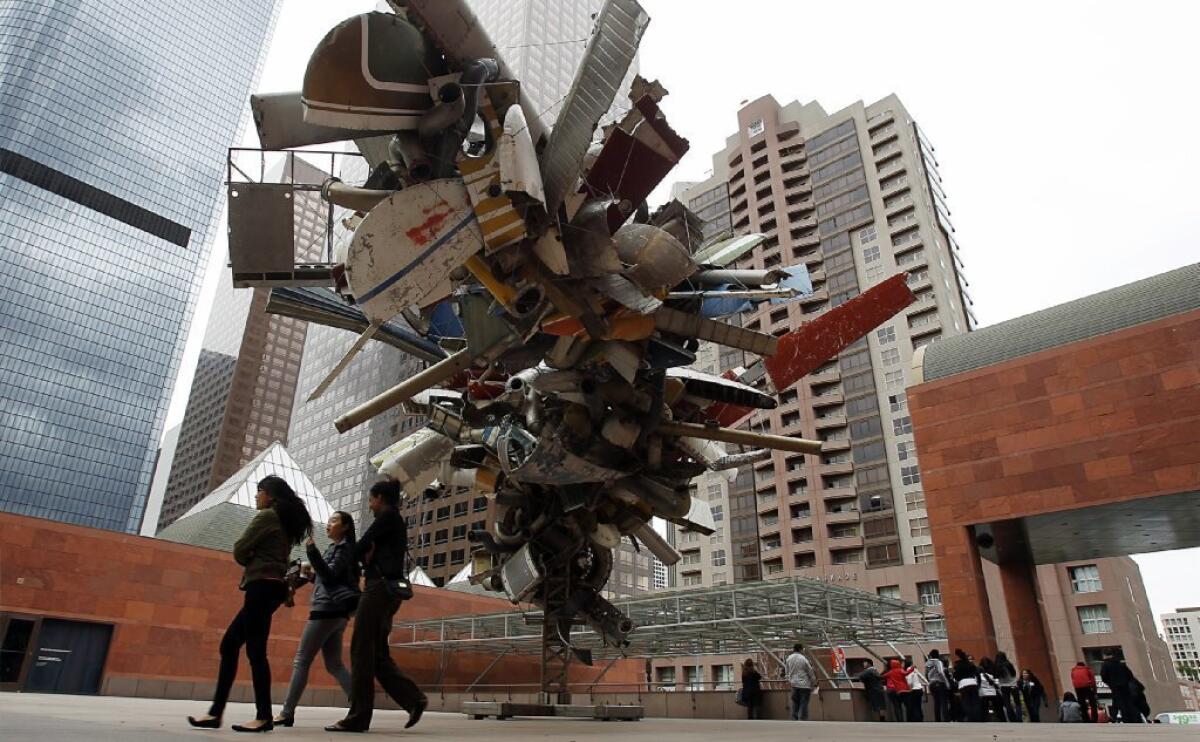
From the Music Center on Bunker Hill to the Central Library at West 5th Street, Grand Avenue runs just over half a mile. But those four city blocks contain an enticing thumbnail sketch of shifting ideas in mostly 20th century public art.
In 1969, a 29-foot-tall bronze sculpture by Jacques Lipchitz was dedicated on the Music Centerâs main plaza. Itâs among the cityâs most familiar public artworks.
Chunky, muscular, primeval male and female figures rise up, standing on one anotherâs shoulders, to greet a teardrop-shaped aureole being lowered by a dove. Inside the aureole, an abstracted female form spreads her arms wide in a welcoming gesture.
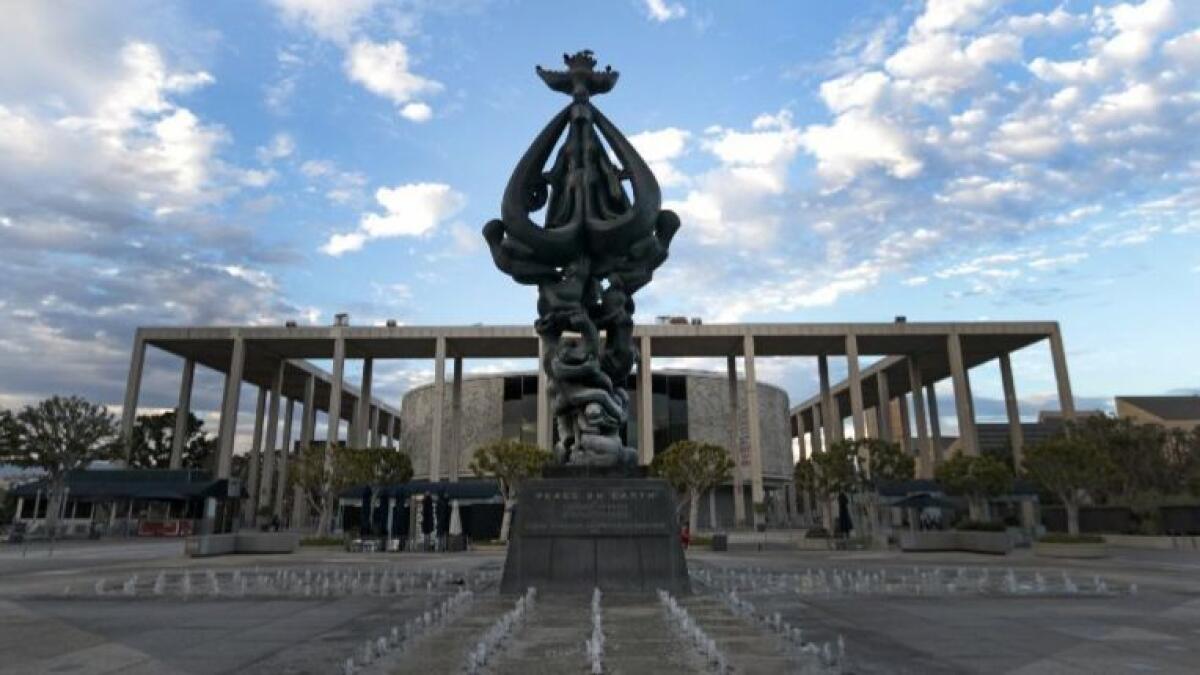
Special report: Grand Avenue project Âť
Lipchitz, a sculptor of allegorical subjects in Cubist forms, titled the work âPeace on Earth.â The composition derived from an earlier sculpture, designed by the Lithuanian-born Jewish artist for a Catholic church in France. But his abstractions transform religious imagery into something more secular and universal: The Madonna is now a picture of openhearted warmth, with the stylized pelicans around the aureoleâs base shedding their traditional symbolism of Christian sacrifice to become a decorative interlace of celebratory nature. The dove, by the 1960s an international icon signifying peace, crowns a monolith erected at the Vietnam Warâs height.
And war is very much what drove the eraâs public art â not necessarily the Southeast Asian conflict, but more generally the Cold War that dominated Americaâs cultural life. âPeace on Earthâ embodies public art as an implement of Cold War mediation. Different from Soviet government artistic control, it functioned as an emblem of free expression for a modern American cultural center.
A block and a half away, a radically dissimilar sculpture has been telling a very different story.
Until recently, the plaza of the Museum of Contemporary Art was dominated by a towering cluster of tattered airplane parts â dented nosecones, chopped up fuselage, busted stabilizers, bruised manifolds â held together by half a ton of steel wire, tied to hold all those fragments in a tense grip. The explosive form stood 25 feet high and 54 feet wide, poised atop a relatively slender, vertical steel support.
The descriptive title of L.A.-based artist Nancy Rubinsâ sculptural extravaganza ends with a nod to its original location and eventual resting place: âChasâ Stainless Steel, Mark Thompsonâs Airplane Parts, About 1,000 Pounds of Steel Wire, and Gagosianâs Beverly Hills Space, at MOCA.â
The broad, V-shaped contour suggests a bird in flight â nature distantly recalled via Industrial Age detritus. (Birds regularly build nests within the open constellation of forms.) In reality, the steel maelstrom is a material powerhouse of barely contained dynamism â the chaotic brutality of the modern era reconfigured as a carefully considered, orderly work of art. Its tensile strength thrums with potential energy, creation salvaged from a history of epic destruction.
Workmen recently undertook the arduous process of disassembling the mammoth sculpture, in place since 2002, to move it seven blocks east to the plaza in front of MOCAâs Little Tokyo warehouse space, which is being refurbished. (The birdâs nests are being relocated, too.) Last year, the 10-ton Lipchitz bronze scuttled across the Music Center plaza to the edge of Hope Street as part of a redesign of the outdoor space currently underway. Public art isnât always static.
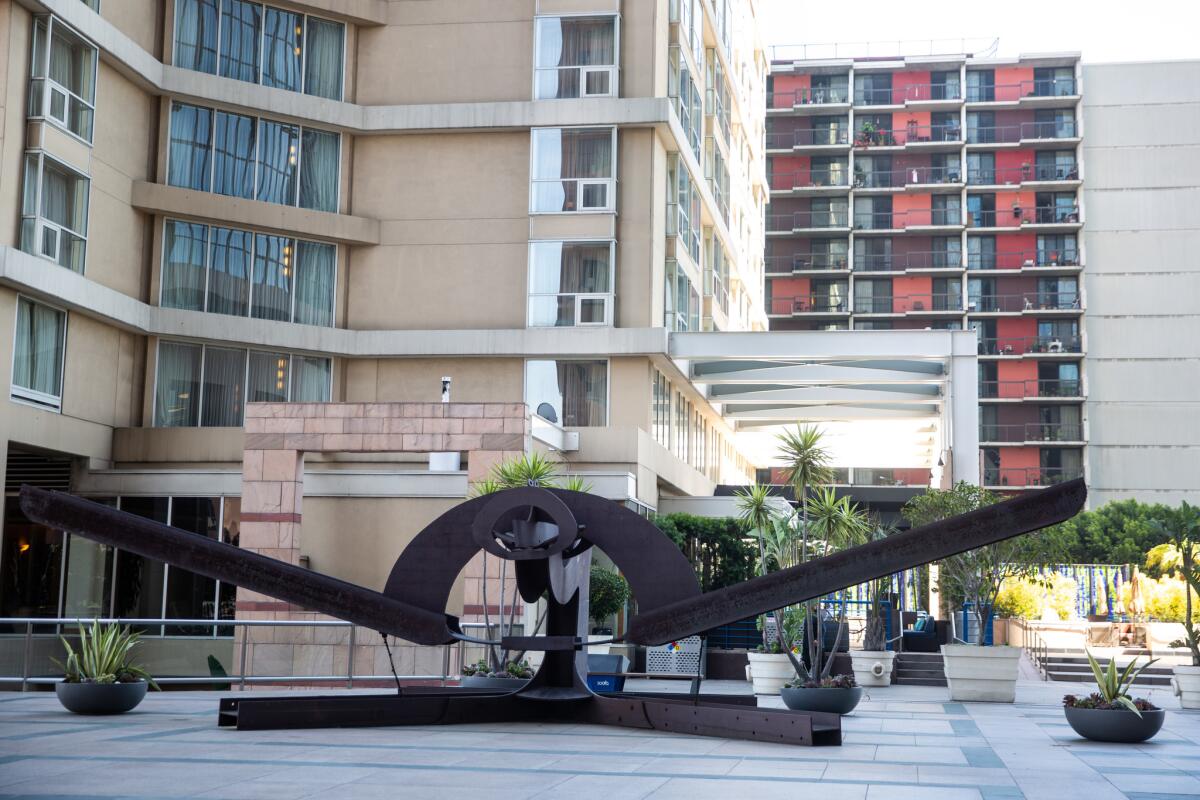
One that is at least semi-fixed has been adjacent to the glass tower at One California Plaza for a couple of decades. Mark di Suveroâs massive, late-1970s âPre-Natal Memoriesâ is a kidâs playful backyard seesaw enlarged to industrial proportions, made from 16,000 pounds of I-beams and welded steel.
I once had the pleasure of taking a wild ride on the giant teeter-totter, when it was first shown at a Venice art gallery. Now in a public place, the two wings had to be tethered by steel cables so that it no longer moves â except in the imagination.
Across the street, the twin-tower complex at Wells Fargo Center is getting a ground-level face-lift that will dramatically reconfigure an aspect of public art that came in the generation after the Lipchitz commission. L.A.âs Community Redevelopment Agency, now defunct, required that one percent of a projectâs development budget be devoted to public art acquisitions. Cold War symbolism shifted toward enhancing the quality of daily urban life.
The mandate was somewhat elastic, also providing the funds for construction of MOCAâs nearby building. But the program came with a little-noticed clause: After 30 years, a work of art was no longer required to remain in the public realm. The Wells Fargo redesign led to the sudden sale of important sculptures by Joan Miro and Jean Dubuffet, which once adorned the now-razed garden atrium designed by Lawrence Halprin.
High construction fencing now obscures the outdoor plaza. Happily, the 30-foot, black-painted mast of âNight Sail,â a mysterious, Cubist collage of nautical and geometric forms in aluminum and steel by Louise Nevelson (1899-1988), protrudes over the top. (Coincidental factoid: In her youth, Nevelson was a studio assistant to Mexican muralist Diego Rivera, whose friendship with young Jacques Lipchitz in Paris also inspired the Lithuanianâs embrace of Cubism.) At 33 tons, shipping the monumental âNight Sailâ off to an auction house for sale was hardly practical. It stays.
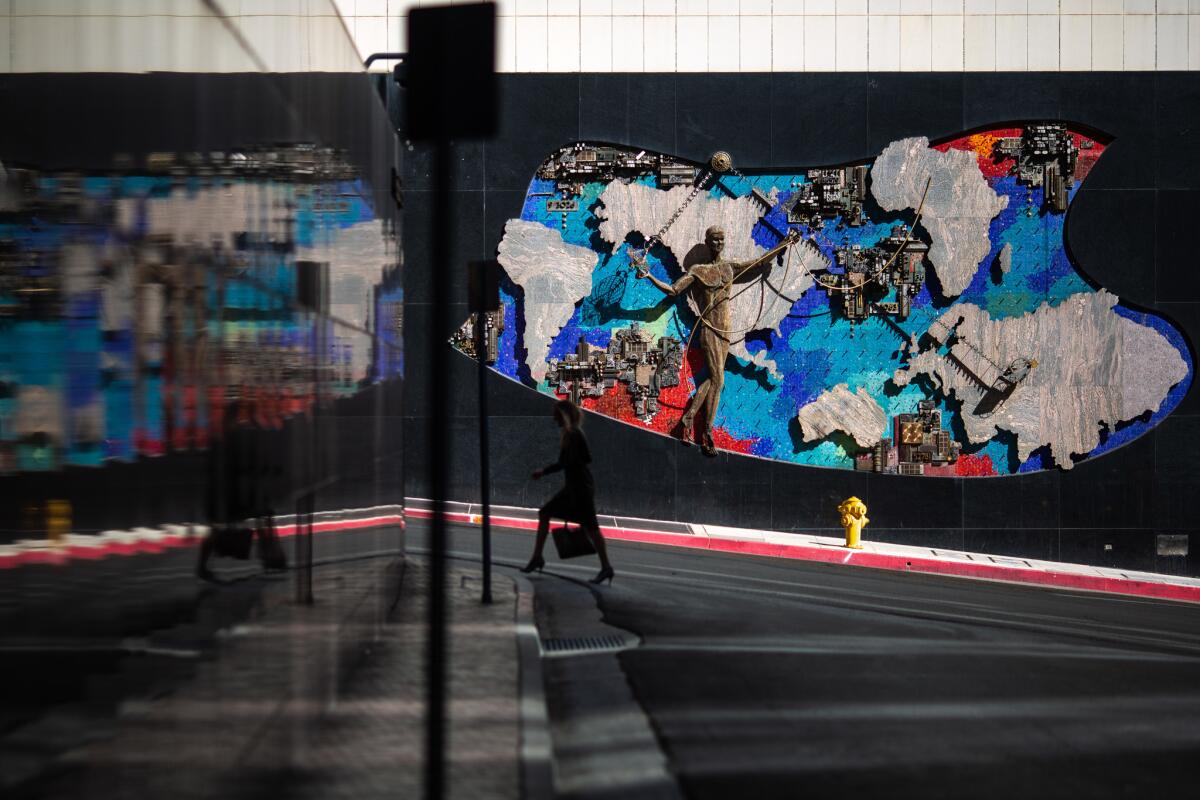
Farther along Grand, a wonderfully kitschy 1961 sculptural relief on the side wall of an AT&T switching center shows the globe linked by undersea telephone cables and satellite relays that ricochet off a fey male nude. In designer Anthony B. Heinsbergenâs topsy-turvy map, South America drifts next to North America, Africa floats above Europe, Australia hovers nearby. Ma Bellâs modern communications system rearranges the worldâs fixed geography.
At the corner of Grand and 5th, a 1930 mural dubbed âThe Apotheosis of Powerâ inside the Art Deco lobby of the CalEdison building, shows the hand of God descending from the sky to bring hydroelectric energy to 16th century English physicist William Gilbert, who coined the word electricity; kite-flier Benjamin Franklin; and an indigenous couple looking like a neutered Adam and Eve. Hollywood production designer Hugo Ballin, the eraâs go-to-guy for corporate murals, rendered an Anglo-American epic in stylistic imitation of Michelangelo.
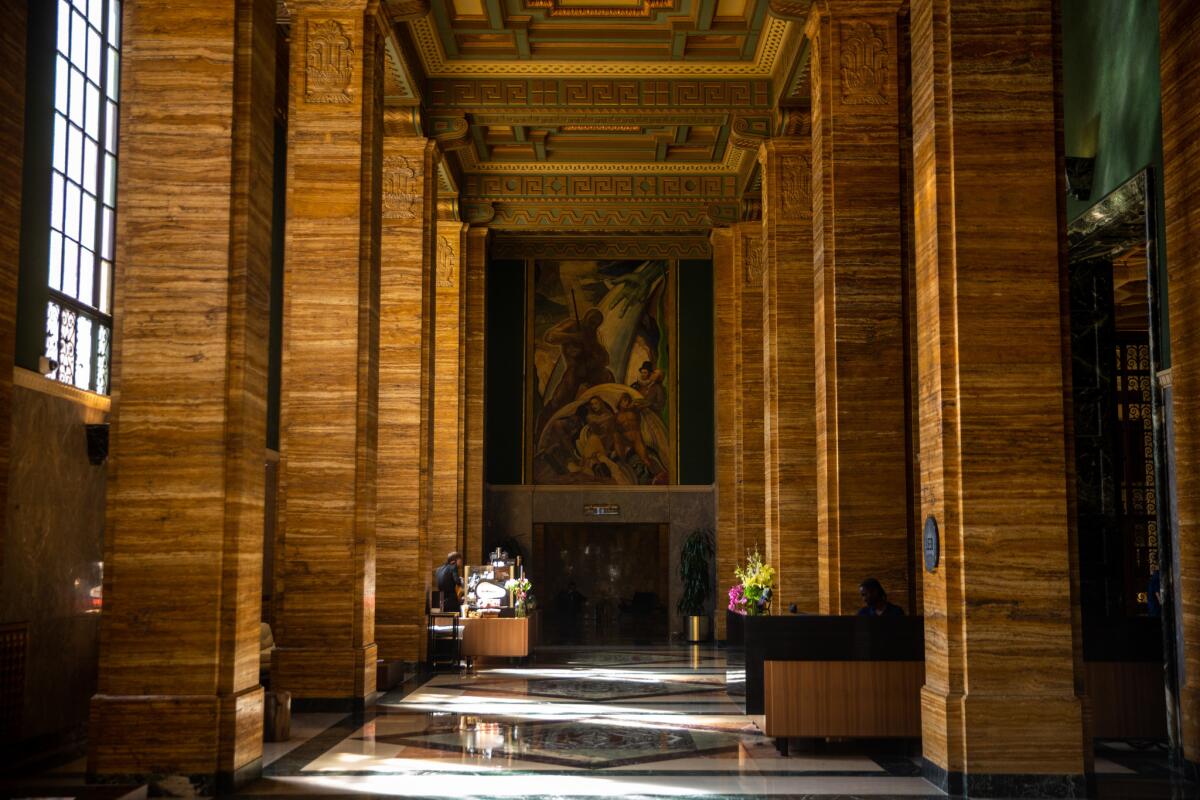
Pass 5th Street to Bertram Goodhueâs Central Library, one of the cityâs architectural masterpieces, and a pair of public murals made six decades apart tell of dramatic change.
A 1932 set of four monumental wall paintings in the main rotunda upstairs charts a storybook fable of Spanish Colonial settlement in California. (Seeing the affable, nearly completed work helped inspire Mexican artist David Alfaro Siqueiros to paint his own radically different 1932 mural, âTropical America: Oppressed and Destroyed by Imperialism,â on a nearby Olvera Street wall.) Gifted literary illustrator Dean Cornwell tells an impossibly sunny story in pastel pictures arrayed around a magnificent globe-chandelier, suspended from an elaborate compass rose painted on the ceiling. Tranquil harmony reigns.
Directly below the rotunda, a visual uproar is underway.
The low-slung ceiling of the first-floor entry lobby now sets the upstairs story spinning. âThe Seven Centers,â a marvelous 1993 Renee Petropoulos mural, invokes the seven continents in bright, flat, vivid hues.
Ornamental patterns and decorative interlaces weave in and out of Celtic, Chinese, Persian, Ghanaian and other styles. The whirling designs, none centered on the roomâs modest Deco chandelier, explode a traditional ceilingâs compass rose.
Along Grand Avenue, one artistâs ceiling is another artistâs floor â in this case, physically and conceptually.
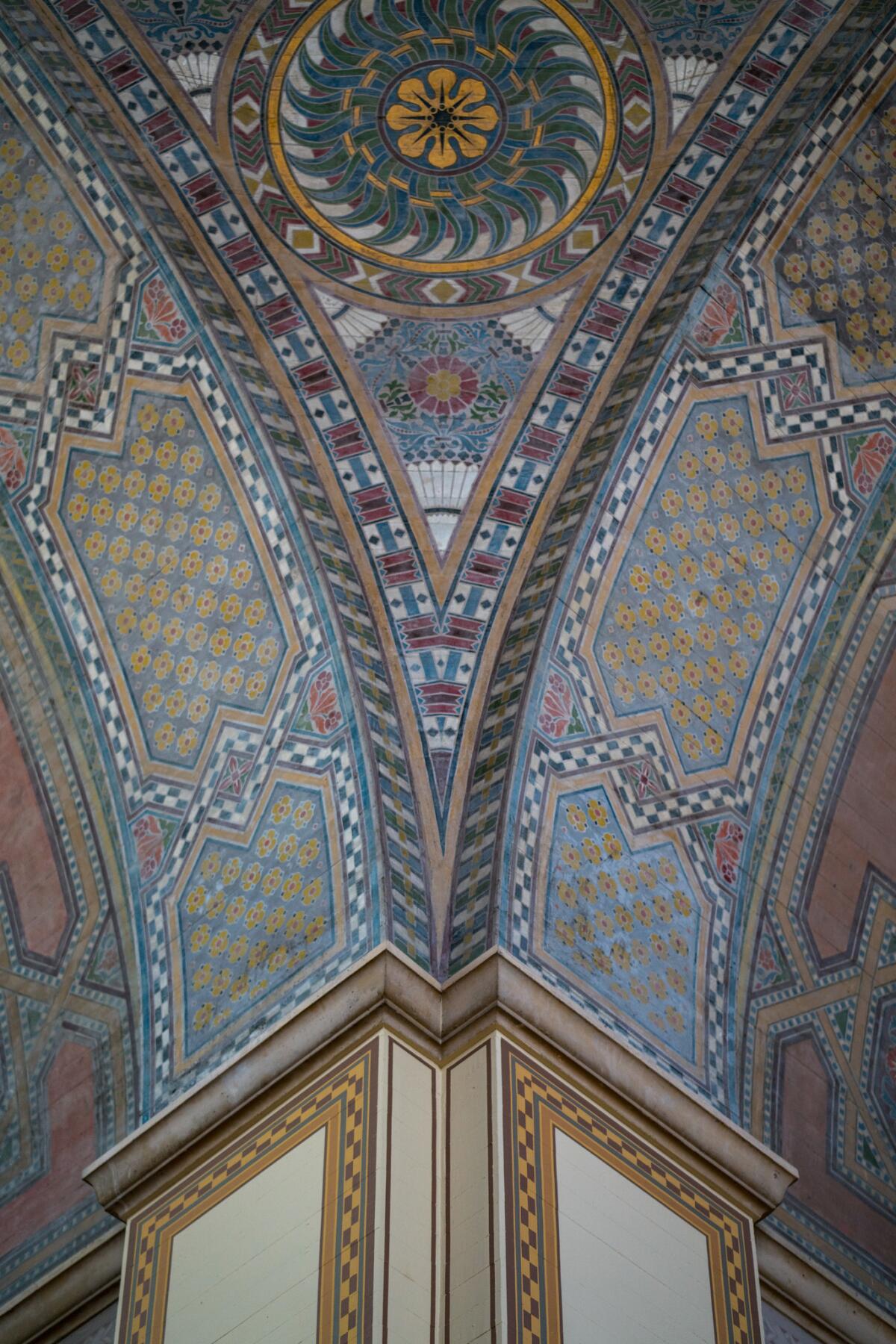
More to Read
The biggest entertainment stories
Get our big stories about Hollywood, film, television, music, arts, culture and more right in your inbox as soon as they publish.
You may occasionally receive promotional content from the Los Angeles Times.











